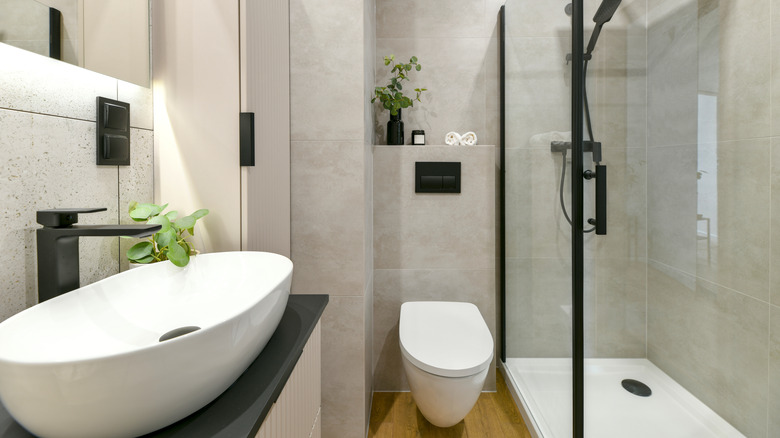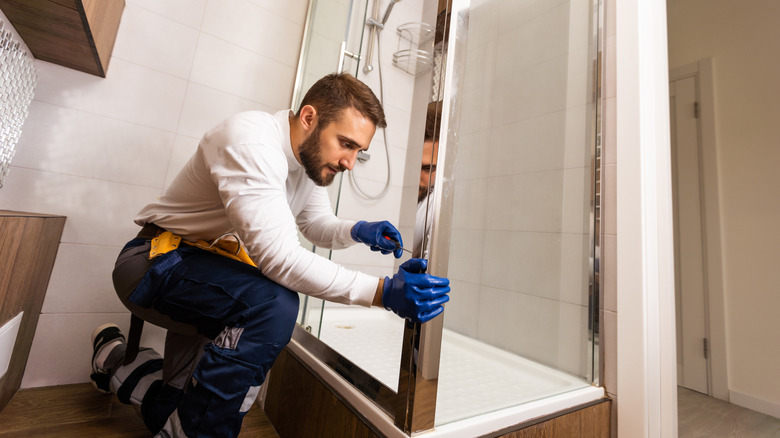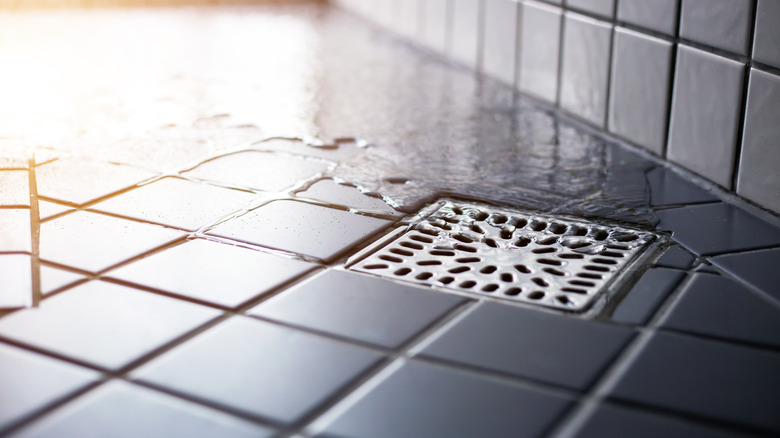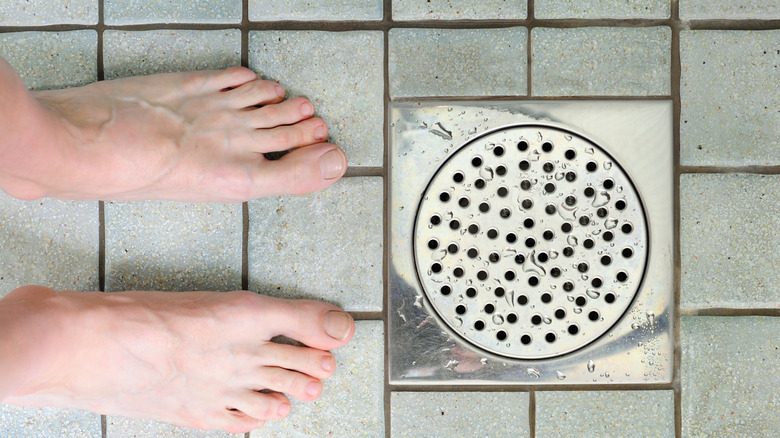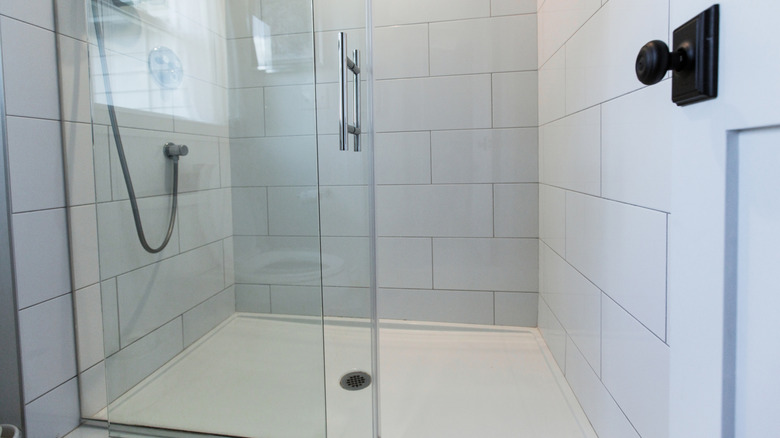Top Reasons Why Shower Pans Fail And How To Prevent It From Happening
Whether you're building a new house or considering shower upgrades that will make you never want to get out, it's not just aesthetics you need to consider. Having a beautiful bathroom doesn't matter if the shower pan, the waterproof base on the floor of your shower, fails. These can be exposed to create the surface you stand on if constructed of a durable material like stainless steel — but typically, they serve as the foundation for a tiled or acrylic shower floor. A shower pan is an essential part of preventing leaks and protecting your subfloor and walls. Common causes of failure include incorrect installation of waterproofing materials, improper sloping, movement, and poor quality.
Preventing issues during the installation process helps you avoid damaging leaks. However, it's not always easy to spot shower pan problems before they cause damage. Some signs of a potential issue include movement in the floor and cracks in the shower pan. If damage is already present, you might notice water stains, leaks into the ceiling below the shower, water on your bathroom floor, or musty odors that signal mold growth.
You can also check for an issue by performing a flood test after installing a shower. To perform the test, block the shower drain and fill it with water from a sink or another source. Note the height of the water level at the beginning of the test. Wait at least 24 hours and check the water level to see if it has gone down, which could indicate leaking due to shower pan issues.
Waterproofing mistakes when installing your shower pan
Once you choose the right type of shower pan for your bathroom, it's important to handle the installation process correctly. There are different components that can be used to create a waterproof base for the shower pan, including waterproofing membranes, paint-on waterproofing products, and hot mopping, which uses layers of felt and asphalt to waterproof the floor.
One common installation mistake is combining these methods, such as painting on a waterproofing layer over a waterproofing membrane. Instead of doubling up on waterproofing, you could be interfering with how each method works, so choose one method and stick to it. This can depend on the type of shower you're installing, your budget, and your preferences — but whichever type of waterproofing you choose, follow the precise steps for its installation without adding in extra techniques or combining methods.
While installing your shower pan, take your time to ensure you're completing every step correctly; for example, if you're creating a mortar bed with a membrane liner for your shower floor, use the trowel carefully to avoid puncturing the membrane. If you hire a professional to install the shower, ask them to explain their process and break down each step so you understand what they'll be doing. Asking these questions before you hire someone helps you avoid situations where the installer makes questionable decisions. If the processes they describe don't make sense or don't follow the typical steps for a specific method, consider choosing a different company to perform the work.
An improperly sloping shower pan can lead to drainage issues
Problems with the shower pan slope could be why your shower is leaking water into your basement. Shower pans are designed to slope so that the water naturally flows toward the drain. Low or high spots on the shower pan could block the water flow and prevent it from reaching the drain; these variations in the floor level can happen if the subfloor or mortar bed is uneven. Some installers use wood shims to fill gaps between the pan's supports and the subfloor, but incorrect shim thickness can cause high spots. Due to the moisture in the shower area, the wood could eventually rot, causing sunken areas that also interfere with drainage. If the water can't flow freely, it sits in the shower and could back up onto the bathroom floor.
Before installing your shower pan, check the subfloor or mortar bed to ensure it's level and has the proper slope. If you need to use shims for even support, choose plastic shims instead of wood to keep them from rotting. You can also use a flexible drain fitting with a prefabricated pan that has some flex to it to prevent gaps between the drain and the pan. This can be an effective way to head off problems with the drain itself, which can also affect the shower pan. If the shower pan flexes and becomes distorted, the drain may not fit securely. Even if the pan is sturdy, incorrect drain installation could cause leaks in the shower floor.
Lack of stability can cause the shower pan to shift
No matter how sturdy a shower pan is, it can fail if it moves after installation. Inadequate support may allow the shower pan to shift when you use it, or water damage and leaking may have caused the subfloor to deteriorate, allowing an up-and-down movement called deflection. If the shower pan moves, the material can start to crack, which allows leaks and could damage tiles and grout if you have a tiled shower floor. When you are experiencing this issue, you can often see the material sinking or moving as you step on it.
Preventing movement starts with installing a sturdy subfloor or mortar bed to create a stable foundation for the shower pan. Using proper installation methods, including using the correct sealant and bolts to secure the pan, is also essential for having a shower pan that doesn't move. Prefabricated shower pans often don't require a mortar base, as they rely on support ribs to keep the floor sturdy. However, you can install the shower pan on a mortar bed even if it's not required for the installation. This creates a more sturdy base with less room for flexing and moving.
Quality matters when installing a shower pan
Your shower pan is generally not an area in which you'll want to cut costs. An inexpensive, low-quality shower pan isn't likely to last as long as pricier, higher-quality options. Lower-quality products might lack adequate support ribs, which could allow movement or damage, and shower pans also have weight limits. If you exceed those limits, you could damage the mortar bed or the pan — so if possible, check the weight limit of any shower pan you're considering installing.
Before buying a new shower for your bathroom, you should also consider the best material for your shower pan. Acrylic and fiberglass are inexpensive options, but they're often not as durable as composite shower pans, which are engineered using multiple materials to incorporate the strengths of each. Explore all of your options to avoid buying a low-quality shower base that could crack or flex with regular use, and keep in mind that thicker materials hold up better in the areas between the pan supports.
